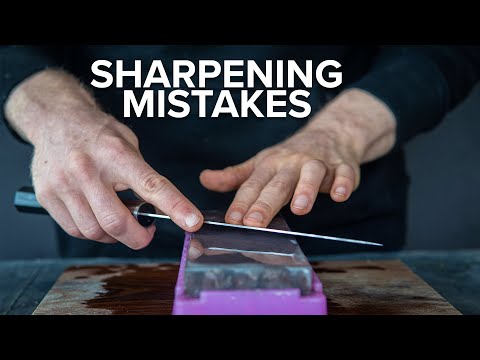
ef6c39901e135bd188183273df7c1ab4
Sharpening stones are an essential tool for any kitchen or workshop. They are used to sharpen knives, scissors, and other tools to keep them in top condition. In this guide, we will discuss the basics of sharpening stones and how to use them properly. We will also provide tips and tricks to help you get the most out of your sharpening stone. With the right knowledge and practice, you can keep your tools sharp and ready for use.
How do you use a sharpening stone for the first time
Sharpening stones are an essential tool for keeping your knives and other tools sharp. If you’ve never used a sharpening stone before, it can be a bit intimidating. But with a few simple steps, you can learn how to use a sharpening stone and keep your tools in top condition.
Step 1: Choose the Right Stone
The first step in using a sharpening stone is to choose the right stone for the job. Different stones are designed for different types of blades and tools. For example, a diamond stone is best for sharpening hard metals like steel, while a ceramic stone is better for softer metals like aluminum. Make sure you choose the right stone for the job.
Step 2: Prepare the Stone
Once you’ve chosen the right stone, you’ll need to prepare it for use. Start by soaking the stone in water for 10-15 minutes. This will help to remove any debris or dirt that may be on the stone. Once the stone is soaked, use a damp cloth to wipe it down and remove any remaining debris.
Step 3: Start Sharpening
Now that your stone is ready, it’s time to start sharpening. Start by placing the blade of your tool on the stone at a 20-degree angle. Then, using a circular motion, move the blade across the stone. Make sure to keep the angle consistent as you move the blade across the stone. After a few passes, you should start to see a sharp edge forming.
Step 4: Test the Edge
Once you’ve finished sharpening, it’s important to test the edge. To do this, take a piece of paper and place it on a flat surface. Then, take the blade and lightly drag it across the paper. If the blade cuts through the paper easily, then you’ve successfully sharpened the blade.
Step 5: Clean and Store the Stone
Once you’ve finished sharpening, it’s important to clean and store the stone properly. Start by wiping the stone down with a damp cloth to remove any debris. Then, store the stone in a dry place away from direct sunlight. This will help to ensure that the stone stays in good condition for years to come.
Conclusion
Sharpening stones are an essential tool for keeping your knives and other tools sharp. With a few simple steps, you can learn how to use a sharpening stone and keep your tools in top condition. Just remember to choose the right stone for the job, prepare the stone, start sharpening, test the edge, and clean and store the stone properly.
Do you wet a sharpening stone before use
Sharpening stones are an essential tool for keeping your knives and other tools sharp. But do you need to wet a sharpening stone before use? The answer is yes, you should always wet a sharpening stone before use.
Sharpening stones are made from a variety of materials, including natural stones, synthetic stones, and diamond stones. Each type of stone has its own unique properties and requires different preparation before use. Natural stones, such as Arkansas stones, should be soaked in water for at least 10 minutes before use. Synthetic stones, such as diamond stones, should be lubricated with oil or water before use.
Wetting a sharpening stone before use is important for several reasons. First, it helps to keep the stone from clogging with metal particles. Second, it helps to keep the stone from becoming too hot during use. Third, it helps to keep the stone from becoming too dry, which can cause it to become brittle and break. Finally, it helps to keep the stone from becoming too slippery, which can make it difficult to use.
When wetting a sharpening stone, it is important to use the right type of liquid. Water is the best choice for natural stones, while oil is the best choice for synthetic stones. It is also important to use the right amount of liquid. Too much liquid can cause the stone to become too slippery, while too little can cause the stone to become too dry.
In conclusion, it is important to wet a sharpening stone before use. This helps to keep the stone from clogging, becoming too hot, becoming too dry, and becoming too slippery. The type of liquid used and the amount of liquid used should be determined based on the type of stone being used.
Which side of sharpening stone to use first
Sharpening stones are essential tools for keeping knives and other tools sharp. Knowing which side of the sharpening stone to use first is important for getting the best results.
Coarse Side
The coarse side of the sharpening stone is usually the side with a rougher texture. This side is used to remove any nicks or burrs from the blade. It is also used to sharpen dull blades. When using the coarse side, it is important to use a light pressure and to move the blade in a circular motion.
Fine Side
The fine side of the sharpening stone is usually the side with a smoother texture. This side is used to refine the edge of the blade and to give it a polished finish. When using the fine side, it is important to use a light pressure and to move the blade in a circular motion.
Conclusion
When using a sharpening stone, it is important to know which side to use first. The coarse side should be used to remove any nicks or burrs from the blade and to sharpen dull blades. The fine side should be used to refine the edge of the blade and to give it a polished finish.
Thank you for reading our guide on how to use a sharpening stone. We hope that you now have a better understanding of the process and can use it to sharpen your tools with ease. Goodbye and good luck!













